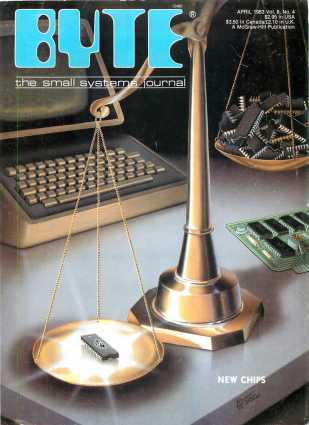
This diagnostic tool can help you make working serial connections.
[author : Steve Ciarcia]
The 16000 brings to microcomputers features formerly available only on much larger systems.
[author : Glenn Leedy]
This 16-bit processor with multiple 32-bit registers is considered by many experts to be the most powerful, yet easy-to-program microprocessor available.
[author : Thomas W. Starnes]
Explore the heart of a smart terminal.
[author : Brian Cayton and Mort Herman]
A first look at the new wave of advanced computers.
[author : Phil Lemmons]
The 80186 is the first integrated circuit that attacks the cost problem in 16-bit microcomputers.
[author : Tony Zingale]
This chip lets you perform mathematical operations with 18 decimal digits of accuracy.
[author : R. B. Simington]
The NEC 7220 GDC is a new item of sophisticated graphics hardware for microcomputers.
[author : Steve Levine]
NAPLPS can draw irregular lines, compress repeated code segments, define new text characters, and divide the display screen into separate fields.
[author : Jim Fleming]
A brief review of virtual-memory concepts, including an examination of four new memory management chips.
[author : Stephen Schmitt]
Advances in hardware, specifically microprocessors and storage devices, are forcing software houses to make some far-reaching decisions.
[author : Phil Lemmons]
The microcomputer industry has made great strides in the past 100 years. Read about what the industry looked like just a short century ago.
How to connect a parallel-port printer to the VIC-20.
[author : Joel Swank]
This installment covers choosing the disk drive. the disk controller. and the power supply and building the host computer adapter.
[author : Andrew C. Cruce and Scott A. Alexander]
Terminal concerns for Wordstar users, BASIC comments, and a bunch of useful utilities are reviewed by the lord of Chaos Manor.
[author : Jerry Pournelle]
Take advantage of the low cost of dynamic memory.
[author : Cameron Spitzer]
Niklaus Wirth, creator of Pascal, brings us a general-purpose systems implementation language based on modules.
[author : Joel McCormack and Richard Gleaves]
Macrocircuits and time-saving features make this new simulator easy to use.
[author : Robert M. McDermott]
Consider this helpful alternative to structured programming and modular design.
[author : Gregg Williams]
[author : Phil Lemmons]
Innovations in microprocessor and support chips are closing the gap between the speed and power of minicomputers and that of micros. As Robert Tinney's cover illustrates, the scales are tipped in favor of the l6-bit chips. "The National Semiconductor NS16000 Microprocessor Family" by Glenn Leedy introduces you to the NS16032 processor and its related chips. "Design Philosophy Behind Motorola's MC68000" by Thomas W. Starnes begins a multi-part study of the heart of machines such as the Lisa and the Radio Shack Model 16. In "Intel's 80186." Tony Zingale describes this new chip that combines the functions of the 8086 and several support chips in one device. "The CRT 9007 Video Processor and Controller" by Brian Cayton and Mort Herman discusses a sophisticated chip that greatly simplifies the design of smart terminals. Steve Levine looks at "Super Graphics Hardware from NEC." "The Intel 8087 Numerics Processor Extension" by R. B. Simington describes the theory and use of this coprocessor chip to speed up numeric computations on 8086/8088-based computers. In the first BYTE West Coast report, Phil Lemmons brings us news of the way in which software houses are responding to the new advances in hardware. Steve Ciarcia tells you how to "Build an RS-232C Breakout Box." Plus our regular features.
